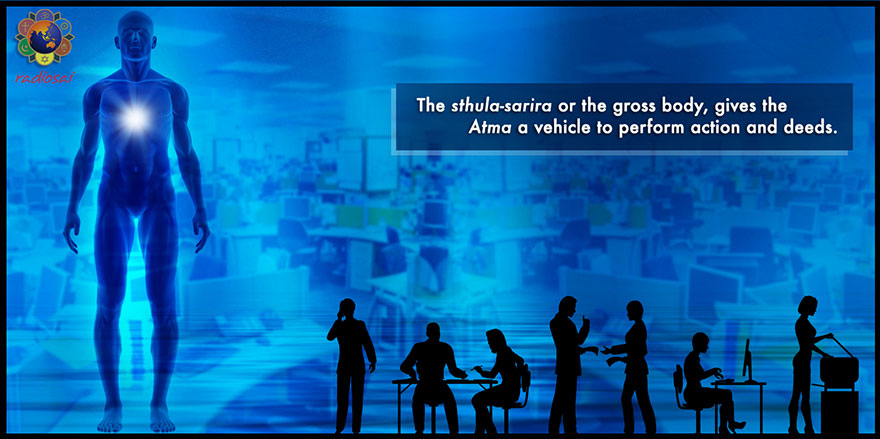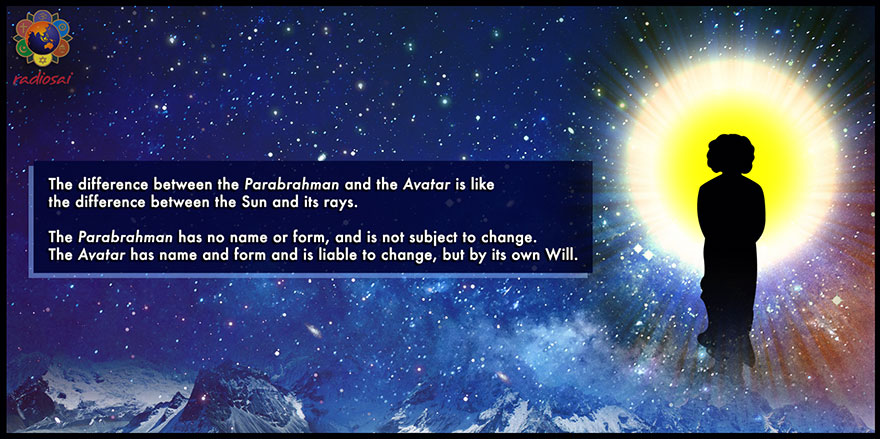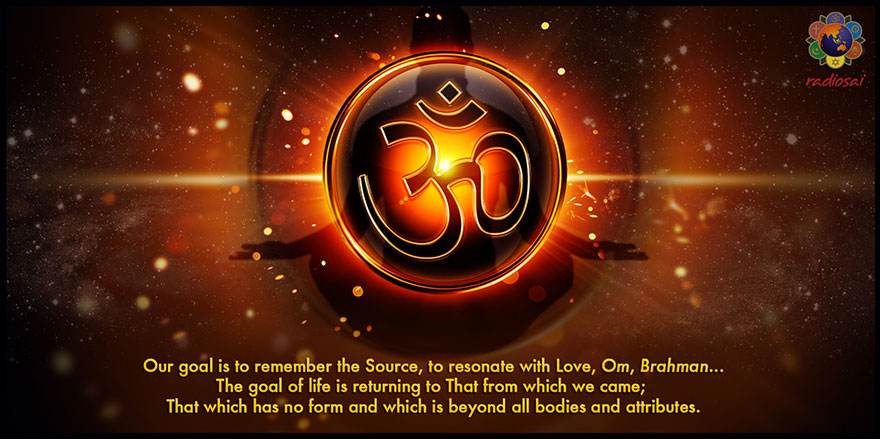|
|
| 'Like' us on Facebook | Follow us: |
Posted on: May 05, 2016
SATHYA SAI BABA ON
THE STHULA (GROSS), SUKSHMA (SUBTLE)
AND KARANA (CAUSAL) WORLDS
Part 02
by Ms. Christan Mackenzie
Gold Coast, Australia
These bodies are examined individually below in a little more detail.
Sthula (Gross)
Sthula the ‘outer temple’ (prakaram) is associated with bhur (gross world/body). It pertains to the physical world and its quality is known as material, thus it is also called the ‘material world’.
The sthula-sarira, the gross body, is related to the waking state, or wakefulness. In man it specifically means the physical body. Its purpose is to give the Atma a vehicle to perform action and deeds. The physical world gives man the opportunity to act on Truth – to experience the subtle (and beyond).
 |
The body of man is associated with the Annamaya kosa, the food sheath. This is the first of the five sheaths which are said to encase the Atma in Maya (delusion). The Annamaya kosa ‘feeds’ into all the other sheaths (which depend upon it to function), and for this reason eating properly and maintaining bodily health is said to be very important for spiritual progress.
The sthula of human beings has twenty-five constituents – the pancha pranas (five vital airs), pancha jnanendriyas (five subtle elements related to the senses), the karmendriyas (the five organs of bodily action), the five Inner Instruments and the pancha bhutas, (the five elements).
When man experiences anything through the body, the experiencer is known as the anthah-karana or cogniser. This is comprised of the mind, intellect, ego and subconscious (manas, buddhi, chittha and ahamkara.)
It is important to distinguish how the subtle world operates for man when he is in the waking state. The gross world is perceptible to our senses, while the subtle world is not. However, Baba says the gross world exists for us to learn about the subtle. The interrelationship of the two is discussed in more detail in the section below on the sukshma.
When a person’s heart stops beating, the life force no longer inhabits the body and the body dies, decays and is eventually destroyed, rendered to dust.
The Sukshma (Subtle World)
Sukshma, the ‘inner temple’ is associated with bhuvah (mental world) and it is subtle, without any physical basis and its quality is vibration.
There are two ways we consider Sukshma – the wider subtle ‘world’ of emotion, thought, feeling and higher wisdom, and secondly there is the Sukshma-sarira (subtle/dream body) a vehicle of experience with its constituents of three kosas or body shields.
 |
The Wider Subtle World
Firstly, let’s consider the wider subtle world.
The subtle world is not of the physical realm but operates within it. Bhagawan gives examples of this when He discusses stories in the ancient Hindu texts. In the dialogue with a devotee Baba answers detailed questions about the gross, subtle and causal bodies (and the states beyond) and their relationship to the spiritual heart.
Devotee: How can that be all-pervading?
Baba: Nothing else possesses the extent, the area, the breadth that this firmament of the heart has. See how many scenes, how many feelings, how many conjectures are immersed and embedded in it!
Devotee: Then do we also have a Sun in that subtle sky?
Baba: Of course! Who said no? Without that, how could there be all this splendour, all this light and wisdom and brightness?
Devotee: What is its name, Sai Baba?
Sai Baba: When the heart is the firmament (akasa), naturally, the intellect (buddhi) is the Sun that illuminates that sky. The effulgence of the intellect is as bright as the rays of the Sun, so the intellect is the subtle Sun.
Devotee: Then it is possible that the moon is also in the firmament of the heart in subtle form.
Sai Baba: Why do you ask about all these, one by one? Didn’t I tell you at the very beginning? Every gross name and form has its corresponding subtle name and form. The moon in its subtle form is love (prema), with its cool rays pleasing to the heart. Love is the subtle form of the moon.
Devotee: Excuse me. The Pandavas and the Kauravas waged a war, didn’t they? How are they supposed to have waged the ‘subtle’ war, these ‘subtle’ Pandavas and their opposite number, the ‘subtle’ Kauravas?
Sai Baba: Why do you say “supposed to have waged”? They are waging it even today in the subtle form! In this war, the evil qualities are the Kauravas and the good qualities - truth, righteousness, peace love, and nonviolence (sathya, dharma, shanthi, prema, and ahimsa) - are the five Pandava brothers. The evil qualities are many, so the Kauravas are also a horde. Each one, under their own firmament of the heart (hridayakasa), on their own earthly consciousness, is waging this struggle, every moment. (Sandeha Nivarini)
Thus while the gross world is evident to our senses, the subtle world is imperceptible and experienced in the realm of feeling/intuition/higher wisdom. The Subtle World has form only when we name or try to describe it. Baba talks of this ‘all pervading’ subtle world in terms of thought, feeling, intuitive wisdom qualities - subtle, invisible, intangible - but full of energy and power.
Bhuvah represents the power of the Will. Baba says that every gross name and form has a corresponding subtle name and form. He says the gross world is only there to help you understand the subtle world. When He talks about subtle ‘forms’, it is only in terms of formless qualities, given form by naming and imagining or feeling them and to illustrate a point. For example, he discusses the all-pervading Sukshma-hridayakasa - the subtle firmament of the heart.
Indeed, Baba gave a discourse in which He made this point when talking about the Avatar Krishna.
Krishna revealed that all that is seen in the phenomenal Universe is within Him.
In this context, the difference between Divinity (as Universal Consciousness) and the Avatar (the Divine in human form) should be understood.
The Para-Brahman (the Omni-Self) is not subject to change.
The Avatar has name and form and is liable to change by its own Will.
The Omni-Self has no name or form.
The difference between the two can be illustrated by the example of the sun,
And the rays coming from the sun.
There is no difference in substance between the sun and the sun's rays.
They are one.
Whatever the situation in which the Avatar appears,
There is no limitation on the Avatar's Poornathwam (Completeness).
- Divine Discourse, 01 Oct 1994, Prasanthi Nilayam
 |
The Sukshma-Sarira (Light/Dream Body)
Bhagawan teaches that our goal as man is to remember the Source, to resonate with Love, Om, Brahman - and thus, we need to ‘lighten up’, and become more in tune with the subtle, so eventually we can merge back with the Source. Merging with God, the ultimate goal of man, is about returning to That from which we came, That which has no form and which is beyond all bodies and attributes, Atma Itself. Through spiritual exercise and practice, we progress from the physical to the subtle realms before moving beyond those sequentially. Sai Baba describes this as a process of peeling off the kosas or the body sheaths.
The sukshma-sarira:
• Is a combination of three kosas or shields. It is made up of the Pranamaya, Manomaya and Vignanamaya kosas (the vital air sheath, the mental sheath and the sheath of intellect or discrimination).
• Is the term for the dream or ‘light body’ unique to man because it contains the Vignanamaya kosa, the discrimination/higher wisdom shield which other embodied beings do not have.
• Has all the constituents of the sthula (gross body), except it doesn’t have the organs of bodily action.
• Undergoes the consequences of karma - good deeds and bad which we can understand because it is in the realm of mind, feeling and wisdom.
• Functions in the dream state.
It (the sukshma-sarira) functions in the dream state. In this state, the individual is oriented inwards. In it, man creates for himself a new world. The dream is itself the proof of its reality. It (the sukshma-sarira) is self-constituted with no external relations. In the dream state, everything is created by the mind - forms, sounds and taste, which are experienced without any physical basis for them. This entire experience is limited to the individual concerned. If, for instance, ten persons are sleeping in one room, each person's dream is unique to himself. Each one's actions in the dream are unique to himself. There is no relationship between the dream and the waking state.
- Divine Discourse, 07 Jul 1990, Prasanthi Nilayam
Bhagawan gives examples of this in various discourses. What happens in the dream state is not real in the waking state, and what happens in the waking state is not real in the dream state. For this reason, Bhagawan says the waking and the dream state have no relationship. However He describes the sthula (gross) and the Sukshma (subtle) bodies as twins. How can this be understood? Sai Baba teaches this is because one reflects the other, like object and subject in a mirror.
 |
Scholars have expressed different views regarding the sthula, sukshma and karana sariras. In My view the gross and subtle bodies are like twins, resembling sound and its echo, an object and its image.
In certain places, when you raise a cry you hear the echo. In other places it is present but not audible. The whole universe is an echo of God. It is like a mirror that reflects the image of God.
- Divine Discourse, 02 Jul 1989, Prasanthi Nilayam
The dreaming stage has a subtle form. This stage is called ‘taijasa’. Whatever one has experienced when he is awake, during the waking stage, attaches itself in some form with the mind and continues to appear in the dreaming stage. In this stage, all the nineteen aspects, which we have mentioned earlier, will still appear as subtle forms with a subtle phase. Mind, in the Manomaya Kosa and intelligence in the Pranamaya Kosa, play an important role. Both the waking stage and the dreaming stage are somewhat on the same footing and are equally important.
- Summer Showers in Brindavan, 1977 pp 151-157
The results of man's good and bad actions are experienced by this subtle body. All the pleasant and unpleasant happiness in (reactions to) the world are experienced by the subtle body. This body is also Yathana (experiential) body because it is a prey to various experiences.
Subtle Body contains in it seventeen principles of five sensations, five organs of perception, five vital airs, mind and intellect. Since the subtle body consists of the seventeen principles suffused with ‘Tejas’ (effulgence), the subtle body is called ‘Taijusudu’ (the effulgent one). It is the subtle body which experiences the trials and tribulations, joys and sorrows of the world. Hence, the subtle body is also known as ‘Yathana Deha’ (the suffering body).
- Divine Discourse, 24 May 1993, Brindavan
So what happens in the physical world reflects in the subtle world. The subtle mind is influenced by activities in the physical world (thus it pays out or experiences karmas). On the spiritual path in which we seek to elevate or expand our consciousness, we progress through the sthula-sarira, the Sukshma-sarira and karana-sarira until our consciousness is subsumed in the Divine Bliss of Atma.
Radio Sai Team
What do you think about this Article? Please let us know by writing in to h2h@radiosai.org or you may leave your thoughts in the comments section. Do not forget to mention your name and country.
| comments powered by Disqus |






